VORONOI DIAGRAMS
Submitted By: Kshitij Judah
Roll No: 98178
Course No: CS698R
Course Name: Robot Motion Planning
Instructor: Dr. Amitabh Mukherjee
DEFINITION:-
- The voronoi diagram is a partition of plane into
cells, directed by a set of points P = {P1,P2,......Pn} such that for
each cell corresponding to point Pi, the points q in that cell
are nearer to Pi than any other point P.
dist(q,Pi) < dist(q,Pj); Pi, Pj are elements of set P and i
and j are not equal.
- If we partition the plane into half planes, each half plane
being constructed with the bisector of the line between Pi and Pj , then we
can form the voronoi diagram as the intersection of the half planes.
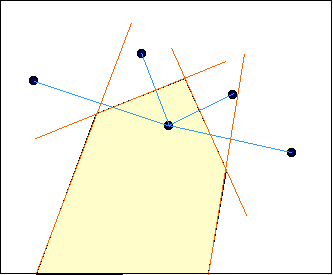

PROPERTIES
(WITHOUT PROOFS):-
- If the points P are collinear, the voronoi diagram consists
of n-1 parallel lines forming n cells.
- If the points P are not collinear, the edges of the voronoi
diagram are segments, or half lines( which may terminate at useful border).
- The number of vertices in a voronoi diagram of a set of n
points is at most 2n-5 and the number of edges are at most 3n-6.
- Voronoi cells or voronoi partitions are convex.
- The voronoi cell of Pi is unbounded if Pi lies on the
convex hull of P.
- "Largest Empty Circle of q wrt P" is the largest
circle whose center is q and which contains no point of P in its interior. A
point q is a vertext of a voronoi diagram if its largest empty circle has
three or more points of P on its circumference. This circle is the
circumcircle of the corresponding Delaunay Triangle.
- The bisector between Pi and Pj defines an edge of the
voronoi diagram of P iff there is a point q in the plane such that its
largest empty circle contains both Pi and Pj on its circumference and no
other member of P.

- The dual of the voronoi diagram is the Delaunay
Triangulation.

Delaunay
Triangulation
APPLICATIONS OF VORONOI
DIAGRAMS:-
There are many fields where voronoi diagrams are used
(although often not by that name). Some of these are as follows:-
- ASTRONOMY:- Identify clusters of stars and
clusters of galaxies.
- GEOGRAPHY:- Analyzing patterns of urban
settlements.
- METALLURGY:- Modeling "grain
growth" in metal films.
- BIOLOGY, ECOLOGY, FORESTRY:- Model and analyze
plant competition (" Area potentially available to a tree",
"plant polygons").
- ROBOTICS:- Path planning in presence of
obstacles.
Apart from above fields, voronoi diagrams are used in computer
science also especially in a branch of computer science called computational
geometry. Below are some problems of computational geometry where voronoi
diagrams are used:-
- Knuth's post office problem:- Given a set of
locations for post offices, how do you determine the closest post office to
a given house?
- Closest pair problem:- Given a set of points, which
two are closest together?
- All nearest neighbors problem:- Given a set of
points, find each point's nearest neighbor.
- Euclidean minimum spanning tree:- Given a graph, find
out a tree which includes all vertices of the given graph and also it should
be the minimum weight tree, weight being measured as the Euclidean distance
between the two vertices forming the edge.
ALGORITHMS FOR CONSTRUCTING VORONOI DIAGRAMS:-
There are many algorithms for constructing the voronoi
diagrams. Some of them are as follows:-
- AN IMAGE SPACE ALGORITHM:-
- Operates in display coordinates, develops the voronoi
diagram on the display.
- Difficult to construct polygons, construct
"regions".
- Easy to construct regions formed by adjacent voronoi cells
with same characteristics.
- It is a quadtree algorithm.
- Recursively subdivide the plane into quadrangles until each
quadrangle contains only points closer to Pi than to any other Pj.
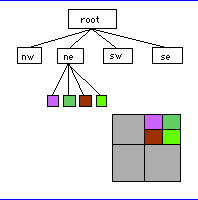
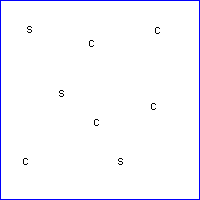

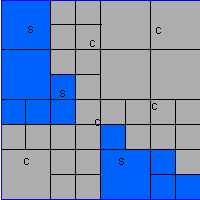
- HALF PLANE ALGORITHMS:-
- Construct the perpendicular bisectors.
- For a given Pi, begin with the nearest Pj and the
perpendicular bisector of this Pi-Pj.
- "Walk around the voronoi diagram, looking for the next
intersection with another bisector or with the border.
- Easy to construct polygons, but somewhat more difficult to
merge adjacent voronoi polygons with same characteristics.
- DIVIDE AND CONQUER ALGORITHM:-
- Divide the input points into two half sets Vl and Vr based
on their geometric positions.
- Recursively create voronoi diagrams VDl and VDr for those
two sets respectively.
- Merge VDl and VDr to create voronoi diagram VD for the
whole set.
- Key operation is the O(n) merge step.
- Merge step builds a bisector polyline that separates the
points( also called sites ) of Vl and Vr and it prunes away the defunct
geometry from VDl and VDr.
- INCREMENTAL ALGORITHMS:-
- Inserts the points one at a time into the diagram.
- When a new point comes, we figure out which of the existing
voronoi cells contains the new point.
- Then "walk around" the boundary of the new
point's voronoi cell (also called voronoi region or voronoi partition)
inserting new points into the diagram.
- Finally delete all the old edges sticking into the new
region.
- Worst case running time is O(n^2).
- It has been proved that if the points are inserted in some
random order, then running time reduces to O(n*logn).
- FORTUNE'S ALGORITHM:-
- It is a sweep line algorithm.
- The intersection of two cones whose axes are vertical is a
parabola.
- If the cones have their apex at the points in P, then these
parabolae lie in vertical planes and their projections onto x-y plane is a
straight line.
- If the field of cones opening towards the +z axis is viewed
from below and the cones are opaque, the view gives the voronoi diagram .
- In fortune's algorithm, a sweep line moves across the x-y
plane, and a sweep plane, inclined at an angle of 45 degrees to the x-y
plane and passing through the sweep line, sweeps through a field of cones. As
it sweeps, it detects voronoi vertices and edges.
- Worst case running time is O(n*lgn).
USE OF VORONOI DIAGRAMS IN ROBOTICS:-
- A path planning technique known as the retraction approach
uses voronoi diagram for path planning.
- It consists of retracting Cfree onto
its voronoi diagram where Cfree means set of all free
configurations.
- This diagram has the property of maximizing the clearance
between the robot and the obstacles.
FEW DEFINITIONS:-
- Let X be a topological space and Y be a subset of X. A
surjective map r X->Y is called a retraction from X to Y if and only if it
is continues and its restriction to Y is the identity map.
- Let B denote the boundary of Cfree. For
any q which is element of Cfree let:
clearance (q) = min || q-p ||; where p is element of B,
where
|| q-p || is the Euclidean distance between q and p.
- Let near (q) = {p | || q-p || =
clearance (q) } where p is element of B.
- The voronoi diagram of Cfree is
the set:
V or (Cfree) = (q | card (near (q)) > 1 }
where q is element of Cfree
where
card (E) denotes the cardinality of the set E.
- V or (Cfree) consists of finite
collection of straight and parabolic curve segments called arcs.
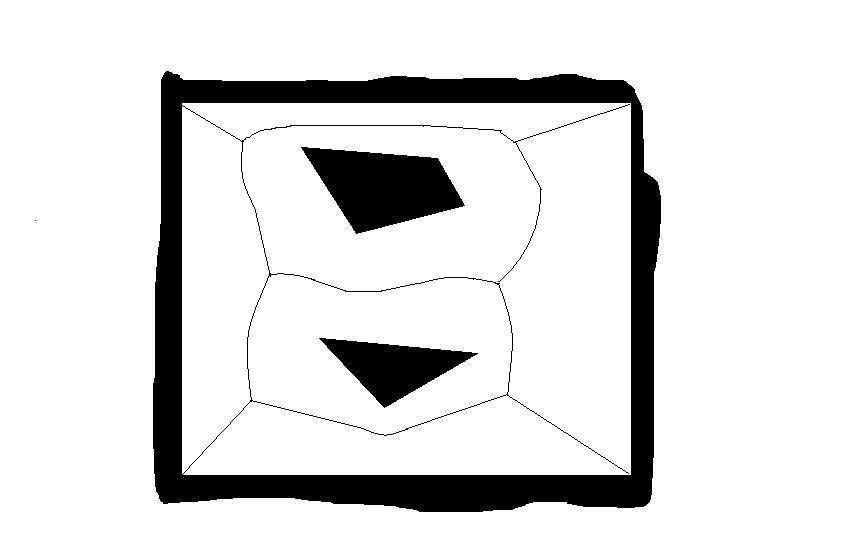
voronoi diagram of Cfree
- Retraction approach proceed as follows:-
- Compute the voronoi diagram V or (Cfree).
- Compute the points r(qinit)
and r(qgoal) and identify the arcs of V or (Cfree)
containing these two points.
- Search V or (Cfree) for a sequence of
arcs A1, A2, .........., An such that r(qinit) is
element of A1, r(qgoal) is element of An and for all i
from 1 to n-1, Ai and Ai+1 share
an endpoint.
- If successful, return r(qinit), r(qgoal)
and the sequence of arcs connecting them, else return
failure.
- Overall time complexity of this algorithm is O(n*logn).
- Also applicable when c-obstacles are generalized polygons.
- Other retraction methods have been been proposed to solve
more involved instances of basic motion planning problem.
- One such method was proposed by O' Dunlaing, Sharir, and
Yap which plans motion of a segment which plans motion of a segment
("ladder") among polygonal obstacles.
- In this method, the three dimensional free space is first
retracted onto a two dimensional variant of the voronoi diagram. In a second
step, this diagram is itself retracted onto a network of one dimensional
curves of Cfree.
- The whole computation takes O(n^2*log(n)*log(log(n))) time.
- Many authors suggested using the voronoi diagram of
the empty subset of a two dimensional workspace as a heuristic guideline to
plan free paths for a robot that can both translate and rotate in a plane.
(e.g. see [Takahashi and Schilling, 1989] ).
- One issue in the above retraction approach is the
calculation of the voronoi diagram of Cfree since
obstacles are polygons and not discrete points. These polygons could be both
convex and concave.
- To find the voronoi diagram for this collection of
polygons, one can either compute the diagram exactly or use an approximation
based on the simpler problem of computing the Voronoi diagram for a set of
discrete points.
- In the latter case, we first approximate the boundaries of
the polygonal obstacles with the large number of points that result from
subdividing each side of the original polygon into small segments.
- Second, we compute the Voronoi diagram for this collection
of approximating points.
- Once this complicated Voronoi diagram is constructed, we
then eliminate those Voronoi edges which have one or both endpoints lying
inside any of the obstacles. The remaining Voronoi edges form a good
approximation of the generalized Voronoi diagram for the original obstacles
in the map.
DELAUNAY TRIANGULATION:-
- It is dual of the voronoi diagram.
- It is constructed by drawing line segments between any two
sites whose voronoi regions share an edge.
- Splits convex hull of the given set of points into
triangles.
PROPERTIES:-
- Each point is connected to its nearest neighbor by an edge
in Delaunay Triangulation.
- It is a planar graph and hence by Euler's formula has at
most 3n-6 edges and at most 2n-5 triangles. Here n is the number of points
(sites) given.
- The empty Circle property: If you draw a circle passing
through the vertices of any delaunay triangle, then no other sites will be
inside that circle.
- It contains "fat" triangles, in the sense that
minimum angle of any Delaunay triangle is as large as possible. If you write
down a list of all angles in the Delaunay triangulation, in increasing order
then do the same thing for any other triangulation, of the same set of
points, the Delaunay list is guaranteed to be lexicographically
smaller.










